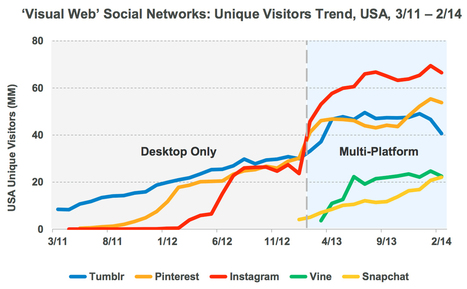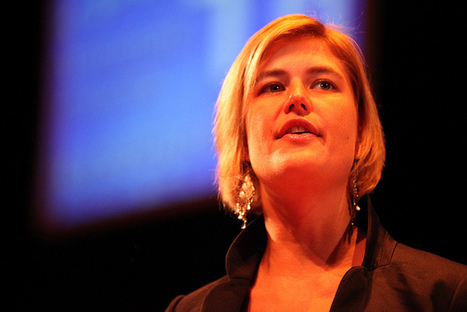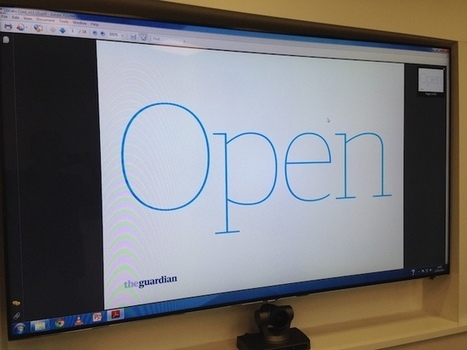 Your new post is loading...
 Your new post is loading...
The last year has turned the United States into a country of information addicts who compulsively check the television, the smartphone and the good old-fashioned newspaper with a burning question: What fresh twist could our national election drama and its executive producer, Donald J. Trump, possibly have in store for us now?
No doubt about it: Campaign 2016 has been a smash hit.
And to the news media have gone the spoils. With Mr. Trump providing must-see TV theatrics, cable news has drawn record audiences. Newspapers have reached online readership highs that would have been unimaginable just a few years ago.
On Wednesday comes the reckoning.
The election news bubble that’s about to pop has blocked from plain view the expanding financial sinkhole at the center of the paper-and-ink branch of the news industry, which has recently seen a print advertising plunge that was “much more precipitous, to be honest with you, than anybody expected a year or so ago,” as The Wall Street Journal editor in chief Gerard Baker told me on Friday....
Dear budding journalist,
Thanks very much for your email! I’m always happy to meet just about anybody, and would love to find some time to have that coffee with you.
Of course I’m also very flattered by the lovely things you said about me, and about how you’d love to have a career in journalism where you might be able to do the kind of thing that I do.
But you won’t. The job I’m doing now was inconceivable when I was your age, and, similarly, if you’re lucky enough to have done well in this industry by the time you’re my age (I’m 42), then you’ll almost certainly be doing something which almost nobody today could foresee....
I hesitate three beats before clicking on a Forbes link. That is the definition of a devalued media brand. And that is precisely what other media companies should fear as they more and more try to fool their readers into thinking that what we used to call advertising is now something else that can comfortably live under brands, enigmatically labeled.
The real lesson of Forbes is that there are no easy answers and quick solutions for transforming legacy media companies. DVorkin became a key tourist attraction for media executives touring New York. I know because I took many of them to meet Lewis. He generously shared his means and methods. But I also told these executives that the path was not without the peril I just described.
Media executives are looking for quick fixes still....
I learned many lessons during my eight years at AOL, none bigger than this: don't let any measure of success blind you to what's in front of your face. In the early 00s, AOL raked in the dial-up dollars.
...For me, statistics like these confirm the news business is on another collision course. A decade or more ago, journalism collided with the freedoms of digital publishing. Next came the collision with social media. Now, it’s colliding with mobile, social and the visual Web. Journalists should take note. Basically, they’re livelihood depends on revenue from paying subscribers and ad dollars. About 75% of ad dollars at media companies with magazines or newspapers still come from those properties (at FORBES it’s down to 45%). Often, it’s even more than that. I suspect traditional revenues at TV and cable networks with big Web sites account for the same.
Mobile ad rates are often one-third of desktop rates, now the main source of digital revenues. So, if traditional ad revenues remain flat at best, if digital pay walls work for only the few, if more news is consumed on smartphones, well, the math doesn’t tell a pretty story unless mobile solutions are found....
A 96-page internal New York Times report, sent to top executives last month by a committee led by the publisher’s son and obtained by BuzzFeed, paints a dark picture of a newsroom struggling more dramatically than is immediately visible to adjust to the digital world, a newsroom that is hampered primarily by its own storied culture.
The Times report was finalized March 24 by a committee of digitally oriented staffers led by reporter A.G. Sulzberger. His father, Times Publisher Arthur Sulzberger, fired Executive Editor Jill Abramson Tuesday, a decision that doesn’t appear immediately related to the paper’s digital weaknesses.
The report largely ignores legacy competitors and focuses on the new wave of digital companies, including First Look Media, Vox, Huffington Post, Business Insider, and BuzzFeed....
I got one of those digital wake-up calls last week when my obsession with data turned to mobile traffic. In April, we had the same number of readers visit our home page via smartphone as we did the desktop.
The same was pretty much true for our popular Billionaires List. We also delivered streams of headlines for mobile readers partly determined by their consumption patterns. Briefly, we even crossed the newest digital divide. During the first weekend of May, 51% of visits were mobile — 39% smartphone, 11.5% tablet. What’s it all mean? ...
...The news, broken by Bloomberg’s Edmund Lee, that once mighty Forbes is going on the block after 96 years of mostly family ownership, has evoked mostly shrugs—another day, another fire sale of a journalism icon—with much of the discussion surrounding how well Bono and other minority investors have done from their investment. That, and what to do with the carcass.
The asking price of $400 million would represent at best a salvage operation for both the Forbes family and Elevation Partners, which includes Bono and former Apple executive Fred Anderson, and which paid, according to Fortune’s Dan Primack, $265 million (higher than previous reports) for its 45 percent stake back in 2006, valuing the company at $588 million. Elevation has already written down its investment by 75 percent.
If Forbes doesn’t get its asking price, it won’t be for lack of effort. Since 2010, the Forbes story has been a strenuous effort to reinvent itself as a digital media innovator, creating easily the most frenetic site in business news. It has assembled an army of 1,200 (that’s one thousand, two hundred) mostly bloggers producing dozens of posts a day (a mere 45 between 5pm Saturday and 5pm Sunday; e.g. “Practical jet packs finally take off”); embracing native advertising, the ethically problematic mixing of ads and editorial, to an extent few mainstream outlets have; amping up its conferencing business (itself not without problems), among other things....
The New York Times Company did the world of journalism a big favor today.The company finally disclosed the exact revenues of its digital business.The numbers were impressive. And they made clear that no one ever needs to fret about the future of journalism again.Specifically, the New York Times reported that the revenue of its digital business is now about $360 million a year....
Traditional journalists probably won't like a lot of how Upworthy's become one of the fastest growing aggregators on the web. But it's hard to question the effectiveness of its methods.
Back in November, the Lab’s own Adrienne LaFrance wrote a number of words about Upworthy, a social packaging and not-quite-news site that has become remarkably successful at making “meaningful content” go viral. She delved into their obsession with testing headlines, their commitment to things that matter, their aggressive pushes across social media, and their commitment to finding stories with emotional resonance.
Things have continued to go well for Upworthy — they’re up to 10 million monthly uniques from 7.5. At the Personal Democracy Forum in New York, editorial director Sara Critchfield shared what she sees as Upworthy’s secret sauce for shareability, namely, seeking out content that generates a significant emotional response from both the reader and the writer....
The best thinking about journalism’s future benefits from its being in touch with technology’s potential. But it can get in its own way when it simplifies and repudiates the intelligence of journalism’s past.
That is happening, to a degree, in a discussion gaining momentum lately that journalism should now largely move beyond fact gathering and toward synthesis and interpretation.
The NSA story is just the latest case that shows the importance, and the elusiveness, of simply knowing what has really happened.
In a Nieman Journalism Lab post, Jonathan Stray made the case recently for moving beyond facts, or what might be called The Displacement Theory of Journalism. “The Internet has solved the basic distribution of event-based facts in a variety of ways; no one needs a news organization to know what the White House is saying when all press briefings are posted on YouTube. What we do need is someone to tell us what it means.”...
When it comes to the traditional media business, there is often a pervasive nostalgia for “the good old days,” when a handful of newspapers and TV networks ruled over the media landscape and profitability was so taken for granted that huge family dynasties with names like Sulzberger and Bancroft were built on that foundation. Many media executives no doubt dream about magically returning to such a time. But what if those days were just an illusion — a kind of accident of history? What would that mean for the future of media? This idea has come up before, but I was reminded of it when I read a Nieman Journalism Lab post about some research being done by Lee Humphreys, looking at the way that communication — and particularly personal communication, through letters and diaries and other pre-digital tools of expression. Although this doesn’t seem to have much to do with how we use ultra-modern services like Twitter or Facebook, there is a lot more to it than you might think....
Evan Williams sees Medium, the blogging platform that he and Biz Stone launched last year, as a modern-day magazine. When Twitter cofounders Evan Williams and Biz Stone launched Medium last year, their goal was for it to be a collaborative publishing tool that connected writers to a larger network. But that vision also hinges on quality, curation and, in some ways, a higher barrier to entry than platforms like Twitter. “We’re going to be a great place for professional writers to write,” Williams told Wired senior writer Steven Levy at the Wired Business Conference in New York on Tuesday. “The magazine is the analog for what we’re doing.”
Ben Huh, CEO of online humor destination, Cheezburger, offers his take on why Gene Weingarten’s recent column was wrong about journalism. Journalism still has much to learn about timeliness when an oft-awarded columnist like Gene Weingarten is 34 days late to a story. Journalism still has much to learn about reporting when the writer of the story was actually never present at the event. Journalism still has much to learn about the audience it supposedly serves when it continues to ignore the wants of its readership. It pains me to watch how much obstructionism blocks the progress of some well-meaning journalists, regardless of the humorous nature of Gene’s column....
|
If trend lines are to be drawn into the future from recent events, the death of the news brand is coming. The clock started not with the rise of the Internet, or the writing of ad-blocking code, but with the philosophy and construction of Web 2.0.
If we go back to 2004, we first see people talking about the Web in new ways. What was once fixed content, placed in fixed locations, became content and context that were separated. What this mean was that websites became a series of frames that could pull content from other places. Pages were dynamic, not fixed, and content could come from anywhere.
Weather sites became portals pulling weather data from other providers, while stock price sites dynamically changed based on data suppliers.The most obvious culmination of this trend was the app.
What this form of construction has done is reward the topmost layer, the “customer interface.” Kayak sells an incredible volume of hotel, car rental and flight inventory merely by owning the interface between service providers and customers, Zilllow does the same with real estate, Seamless with food. Open table, Fandango, Instacart, Uber, Alibaba — the list goes on. The provision of services becomes commoditized, a dumb pipe, while the interface and aggregation layer is the thin surface, scaling fast, and where much of the profit lies....
Jerry Seinfeld, the comedian, once said:
“It's amazing that the amount of news that happens in the world everyday always just exactly fits the newspaper.”
Today, it doesn’t fit.
There is more information, more readily available, more immediately, in more formats, on more devices and to many hundreds of millions more people than ever before.
And it used to be said that freedom of the press is limited to those who own one.
Today, anyone with an internet connection and a Twitter account can make the news. If you choose, the powers that be are you....
The New York Times is a 150 years old. So you don't expect it to be a content marketing pioneer. Here are lessons from a leaked report that may surprise you.
...The revelations from the recently leaked report into their challenges of facing upstarts and competitors is a compelling insight into publishing and also content marketing.
Content is the weapon of choice to gain attention traffic and advertising revenue in a digital world.
Content marketing lessons
One observation from the report that surprised me away was that they didn’t use social media for marketing but for measuring!
Here are some insights into how companies need to adapt in a digital age with publishing and content marketing. I have also included actual excerpts from the report....
We don’t typically write about intra-newsroom politics at Nieman Lab, leaving that to Manhattan’s very capable cadre of media reporters. But Abramson’s removal and Dean Baquet’s ascent has apparently inspired someone inside the Times to leak one of the most remarkable documents I’ve seen in my years running the Lab, to Myles Tanzer at BuzzFeed.
It’s the full report of the newsroom innovation team that was given six full months to ask big questions about the Times’ digital strategy. (A summary version of it was leaked last week, but this is the big kahuna.)
For a moment, let’s not focus on the delicious irony of Buzzfeed breaking the second biggest news about The New York Times this week. The site -- which many a Times staffer probably sniffs derisively at -- uploaded the paper-of-record’s entire 91-page “Innovation Report” that calls for de-emphasizing print in favor of a more sophisticated approach to digital. If you’re in digital, it’s even more intriguing than the news on Wednesday that executive editor Jill Abramson had been unceremoniously shown the door.
More than anything else, the report points to the Times’lackluster, scattershot approach to digital innovation, particularly in audience development, an imperative when so much content and readership comes from the act of sharing. In one of its many trenchant-but-obvious observations, it points out that “our digital content needs to travel on the backs of readers to find new readers.”...
The Guardian has been a journalism leader. Can it build a business strategy that can match its growing global reach?
The Guardian is an enigma.
Long a storied editorial brand, it’s been propelled toward the top of global news audience, both by its open strategy and its hard-nosed journalism. In the past year, it’s broken story after story on NSA spying as the primary recipient of the Edward Snowden files. It’s also expanded its efforts in both the U.S. and Australia, enlarging its global readership. With “open” as its watchword, The Guardian has pushed into every nook and cranny of the social sphere, ascataloged here at the Lab.
But it’s also the Rodney Dangerfield of commercial journalism: It gets no respect. That contradiction — between a worldwide reach and respect and a business strategy that has seemed unstrategic — may be passing into history....
Across the country, newspapers are leaving their old haunts and shifting to cheaper buildings — and taking the opportunity to reshape how their newsrooms look.
... An upcoming white paper I’m writing for Tow will look further into how these space changes facilitate breaking news, but for now, suffice it to say that this kind of organization creates a centralized production and distribution platform for newsrooms hungry to stay on top of the latest.Other newsrooms are taking the opportunity to brand moves as organizational change as well, looking beyond nostalgia.
In an article announcing its move, the Syracuse Post-Standard’s headline read “Syracuse Media Group’s move signals shift to digital-first focus for news and ads.” As the lede put it: “Goodbye, cubicles and copy editors. Hello, collaborative work space and curators.”...
Innovative storytelling, audience engagement, and financial flexibility are key ingredients for newspapers to cope with pressures from competitors, budget constraints, and the speed at which technology is changing."It came as no surprise when The New York Times took home a Pulitzer for 'Snow Fall' - the immersive multimedia package impressed journalists and web designers alike with its seamless integration of text, audio, videos, photos and interactive graphics."The comments in "Trends in Newsrooms 2013," the World Editors Forum's report on the state of the news industry, about the attention-grabbing content, underlined the importance of stories that jump out at readers....
...The company is finding that the most popular content for tablets depends on the title. Golf Digest sees great success with video. Generally speaking, long-form editorial content like actual stories, video and slideshows do well across the board because the tablet is a lean-back device, where consumers aren’t looking for short snippets of content like they are on a mobile phone, for example.
“If you look at the time of day with highest tablet usage it’s usually during prime time or on the weekends,” Reynolds said. “That’s why we are developing tablet-specific content to fit that different mindset. We’re not worried about tablet usage cannibalizing Web usage because Web, tablet and mobile, are all part of a complementary ecosystem.”
Reynold’s said that the biggest opportunity for Conde Nast in the tablet space is the amount of data is has on subscribers. It gives the publisher a look at the preferences that people have for content and advertising on specific devices and Conde Nast can optimize based on that.
I am often asked what it takes to be a great reporter in the digital era. The essential mission, I say, remains the same: to observe, collect and interpret information. Don’t be a generalist; pick a subject, dig deep into it, bring “passion” to the job. That word evokes the obligatory question about objectivity. My response: journalism has always entailed biases, conscious or not. Next, a great reporter engages one-on-one with news consumers, joins social news streams, learns to be a marketer and plays with the technology. I end with this: understand the business models behind the profession — and start to think like an entrepreneur. FORBES has 1,000 writers learning and practicing all of that. Here are four who are leading the way...
The NYT’s multimedia project Snow Fall was a huge success, attracting big audiences and lots of plaudits. ...Snow Fall (and other such attempts) represent a great opportunity and the future for news organizations like The New York Times, especially as they are right now in a losing battle for attention with upstart competitors that include everyone from BuzzFeed to The Huffington Post. If you are the New York Times management, it is time to take a gamble: spend $25 million on creating 100 Snow Fall-like projects.... And in exchange, it got a few million page views, but I am guessing they also built a nice backend infrastructure to create more such projects. As a result, the next Snow Fall is going to cost less, with most future spending going to the creative: words, photos, other multimedia elements and design. So what will the Times (or someone like them) need to get it done? Simply put, a departure from the incumbent thinking, embracing today’s reality and re-imagining the work flow of a big city newspaper. In other words: Re-imagining its business model to factor in the reality of today’s world and forget the legacy of newsprint.Create a new breed of “producer” who can switch between Excel and content.Create a whole new breed of a journalist — one who has old-school values but also the ability to tell a story that works in many mediums of today.Build an editorial creative machine that works differently from a print-centric editorial group....
Twitter is a frenemy," said Jeff Zucker, CNN's new president, as reported by MediaShift. Jeff Zucker was describing the cable news network's relationship with social media and added, “the network uses, relies on -- and is scared by -- social media.” Twitter had a marquee moment last week, particularly late Friday afternoon and evening, that should scare most television news outlets in the business of reporting breaking news. That’s when Boston Marathon bombing suspect Dzhokhar Tsarnaev was cornered by police, trapped and almost bleeding to death inside a covered boat in a backyard in Watertown, Mass....
|
 Your new post is loading...
Your new post is loading...
 Your new post is loading...
Your new post is loading...






































Good read on the next challenge ahead for mainstream media post-election: fake news. What will happen after the circus leaves town?